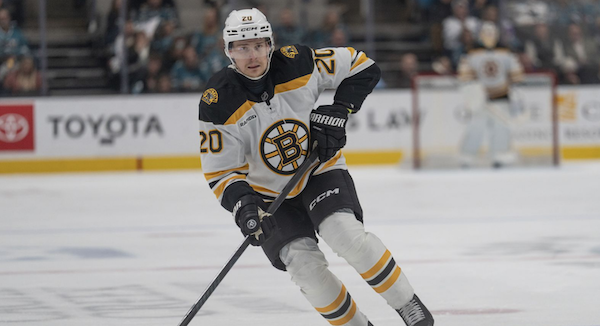
By: Tom Calautti | Follow me on Twitter @TCalauttis
The Boston Bruins don’t have a lot going for them right now. Even the most ardent optimists would struggle to find a silver lining amidst the team’s ten-game losing streak. There aren’t many positives for fans to hold on to, but one pleasant trend (that bodes well for this season and the future) is the play of defensive partners Nikita Zadorov and Henri Jokiharju.
Zadorov joined the organization last July when he signed a six-year, $30-million contract with the Bruins. The plan was to pair him with Charlie McAvoy to act as a physical buffer, eliminating the physical punishment endured by McAvoy and allowing him to elevate his two-way play. That dream was dashed early in the year when injuries and inconsistent play derailed the team’s plans.
Jokiharju was acquired late on March 7th when the Bruins sent a fourth-round pick (acquired in the Brandon Carlo trade) to the Buffalo Sabres in exchange for the Finnish defenseman. In 42 games in Western New York, he posted 3-3-6 and was on the outside looking in of Buffalo’s defensive corps.
This duo was never supposed to be the plan. They’d scoff if you told any Bruins fan in September that their team’s top defensive pairing in March and April would consist of Nikita Zadorov and Henri Jokiharju. But with expectations thrown out the window and a season circling the drain, this new defensive pairing has elevated their game.
After the deadline, interim head coach Joe Sacco was left with a d-corps of Zadorov, Jokiharju, Mason Lohrei, Parker Wotherspoon, Andrew Peeke, Michael Callahan, and Ian Mitchell. He decided to make Zadorov-Jokiharju the team’s de facto top pair, and the results have been nothing short of impressive.
The Black and Gold have suited up for 12 contests since March 7th, with the new duo skating approximately 180 minutes together at even strength. Compared to other pairs that have skated at least 180 minutes together league-wide, the two rank 20th in Corsi (55.8 percent), sixth in expected goals against (6.4), fourth in shot attempts against per 60, and third in goals against per 60.
“I think they just fit well together right now with the defense corps that we have,” said Sacco following the team’s 4-3 loss to the Washington Capitals on April 1st. “They just seem to have some chemistry, and we just feel right now those two guys give us the best look on the back end.”
Sacco commented on the difficulty of their roles based on the current roster, saying, “They’re matching up against top lines too, right now. That’s been their assignment with the injuries we have on the back end.”
The two most impressive stats in the bunch I just listed are the shot attempts against per 60. Zadorov and Jokiharju have shown an ability to stifle opposing offenses and suppress shots on their goal. Shot suppression is one of the key metrics for analyzing the effectiveness of a defensive pairing, and the fact that they’re top-five in the league while playing against opposing teams’ top lines is a massive development.
The fact that their Corsi is above 50 percent is a borderline miracle. The Bruins have been out-attempted in nine of their 12 games since the deadline, and five have been by double digits. This isn’t an offensive duo by any stretch of the imagination, but their capacity for offensive zone possession is impressive no matter how you slice it.
Then there’s the goals against per 60. I’ll repeat the stat (if only for effect): Nikita Zadorov and Henri Jokiharju rank THIRD in the NHL (among pairs with 180 minutes played) in goals against per 60. Simply put, the name of the game is keeping the pucks out of your own net. These two have been able to do that at an elite level since they started skating together.
The difference between this pairing and the rest of Boston’s roster is downright staggering. When Zadorov and Jokiharju were on the ice, shots were 68-65, goals were six to three, scoring chances were 73-61, and high-danger chances were 27-29. When they aren’t on the ice, it’s been a bloodbath.
When any combination of Peeke, Lohrei, Wotherspoon, Callahan, and Mitchell have skated together, shot attempts are 256-380, shots are 115-174, goals are 11 to 24, scoring chances are 108-180, and high-danger chances are 37-74.
This isn’t just a feel-good story at the end of a lost year; it’s a trend that bodes well for the future. If Boston decides to retain Jokiharju (a 25-year-old pending UFA), you can etch him and Zadorov into the middle of your back end. When the team gets McAvoy and Hampus Lindholm back from injury next season, it creates a serious versatility in the d-corps.
Zadorov-Jokiharju can exist as your ‘shut down’ third pairing. Then, depending on the matchup, you can mix and match McAvoy, Hampus Lindholm, Lohrei, and Peeke however you like. This will allow the Bruins to free up McAvoy and Lindholm’s offensive capabilities and take some of the defensive burden off their shoulders.
With this method in mind, you can always have one of McAvoy, Lindholm, or Zadorov on the ice at all times. That type of defensive rotation allows you to have a bona fide defender on the ice throughout a whole game.
I know 12 games is a small sample size, but you can’t deny what the stats say. So far, this pairing works, and if you can re-sign Jokiharju, you can make it work long term. If the Boston Bruins can trot out a d-corps like I described above, it’ll make a bounce-back season a helluva lot more likely.


Leave a Reply